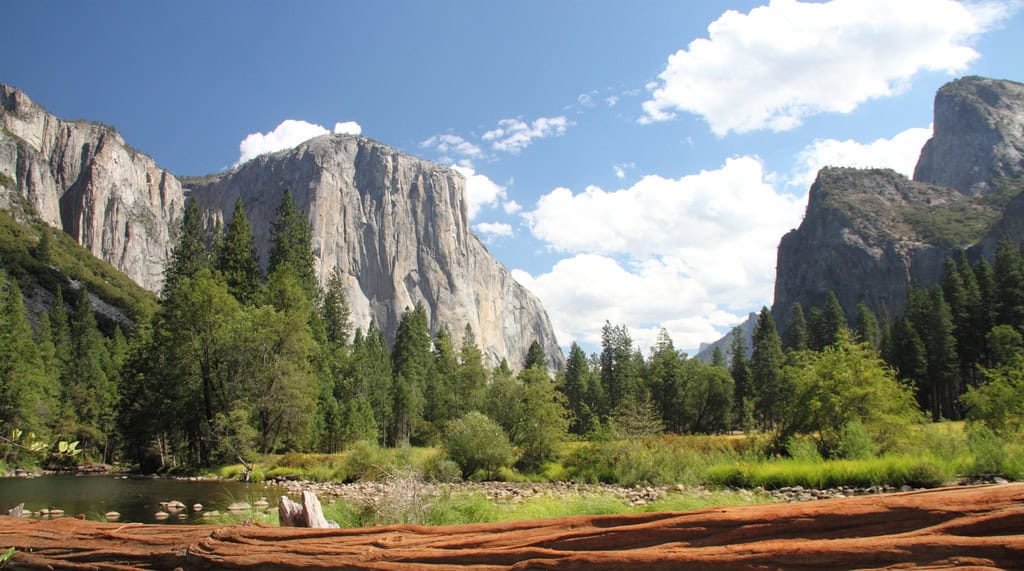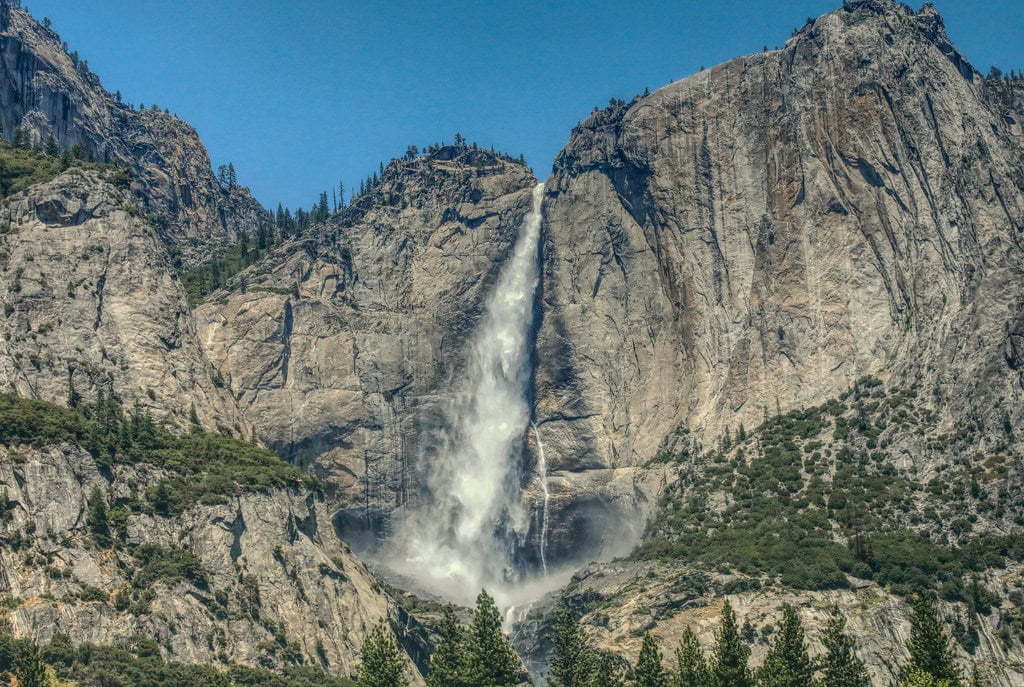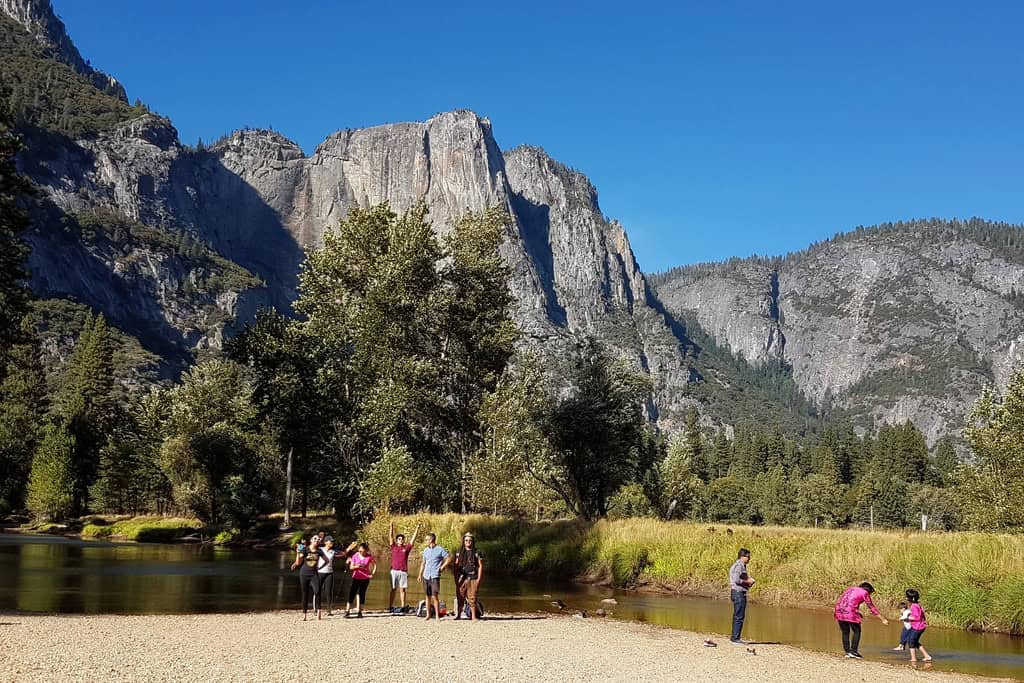
Yosemite National Park, one of the United States’ most beloved natural treasures, is renowned for its stunning granite cliffs, giant sequoias, waterfalls, and diverse ecosystems. Located in the western Sierra Nevada mountains of California, Yosemite covers an area of 748,436 acres (302,687 hectares) and attracts millions of visitors each year. Established as a national park on October 1, 1890, Yosemite has played a crucial role in the American conservation movement and continues to be a symbol of natural beauty and wilderness preservation.
Geology and Landscapes
Yosemite’s landscape has been shaped by geological processes over millions of years, resulting in some of the most iconic natural features in the world.
Granite Cliffs and Domes
The park is famous for its towering granite cliffs and domes, formed by the slow cooling of molten rock beneath the Earth’s surface millions of years ago. Erosion and glaciation have sculpted these formations into their present shapes. El Capitan, rising 3,000 feet (900 meters) above the Yosemite Valley floor, is one of the most famous rock formations, attracting climbers from around the world. Half Dome, with its distinctive sheer face and rounded back, is another iconic feature and a popular destination for hikers.
Glacial Valleys and Waterfalls
Yosemite Valley, the heart of the park, was carved by glaciers during the last ice age. This U-shaped valley is home to some of the park’s most famous waterfalls, including Yosemite Falls, one of the tallest waterfalls in North America with a total drop of 2,425 feet (739 meters). Bridalveil Fall and Vernal Fall are other notable waterfalls, each offering stunning views and photographic opportunities.
High Sierra and Meadows
Beyond the valley, Yosemite’s high country features alpine meadows, glacial lakes, and rugged peaks. Tuolumne Meadows, one of the largest high-elevation meadows in the Sierra Nevada, is a serene area offering opportunities for hiking, picnicking, and wildlife viewing. The high country also includes areas like Tioga Pass and the Cathedral Range, which are popular with backpackers and climbers seeking solitude and adventure.
Flora and Fauna
Yosemite’s diverse habitats support a wide range of plant and animal species, many of which are endemic to the Sierra Nevada region.
Giant Sequoias
Yosemite is home to three groves of giant sequoias, the largest trees in the world by volume. The Mariposa Grove, the largest of these, contains over 500 mature sequoias, including the famous Grizzly Giant. These ancient trees, some of which are over 3,000 years old, provide a glimpse into the region’s ecological history and are a major draw for visitors.
Forests and Meadows
The park’s lower elevations are covered in mixed coniferous forests, featuring species such as ponderosa pine, sugar pine, white fir, and incense cedar. Higher elevations support subalpine and alpine vegetation, including mountain hemlock, lodgepole pine, and various wildflowers. The meadows, particularly those in the high country, are rich in biodiversity and provide important habitat for wildlife.
Wildlife
Yosemite is home to over 400 species of vertebrates, including mammals, birds, reptiles, and amphibians. Black bears, mule deer, and bobcats are some of the larger mammals found in the park. Smaller mammals include the American pika, marmots, and various species of squirrels and chipmunks. The park is also a haven for birdwatchers, with over 250 bird species recorded, including the peregrine falcon, great gray owl, and the Yosemite toad. Additionally, the park’s rivers and lakes support fish species such as rainbow trout and brown trout.
Human History
The human history of Yosemite spans thousands of years, from the indigenous people who first inhabited the region to the establishment of the park and its development as a major tourist destination.
Indigenous Peoples
For thousands of years before the arrival of European settlers, Yosemite was inhabited by Native American tribes, including the Ahwahneechee, a band of the Southern Sierra Miwok. These indigenous people lived in harmony with the land, using its resources for food, shelter, and cultural practices. The name “Yosemite” is derived from the Miwok word “Yohhe’meti,” meaning “those who kill,” a reference to the Ahwahneechee people.
European Exploration and Settlement
The first European Americans to enter the Yosemite region were likely fur trappers in the early 19th century. However, significant exploration did not occur until the mid-1800s. In 1851, the Mariposa Battalion, a militia group, entered Yosemite Valley during the Mariposa Indian War, leading to the displacement of the Ahwahneechee people. The beauty of the valley soon attracted artists, photographers, and tourists, including naturalist John Muir, whose writings and advocacy were instrumental in the establishment of Yosemite as a protected area.
Establishment of the Park
Yosemite’s journey to becoming a national park began in 1864 when President Abraham Lincoln signed the Yosemite Grant, protecting Yosemite Valley and the Mariposa Grove of giant sequoias. This grant marked the first time the federal government set aside land for preservation and public use, laying the groundwork for the national park system. Yosemite National Park was officially established in 1890, encompassing additional areas beyond the original grant.
Development and Conservation
Throughout the 20th century, Yosemite underwent significant development to accommodate increasing numbers of visitors. Roads, trails, and visitor facilities were constructed, often at the expense of natural landscapes. However, conservation efforts also intensified, led by organizations such as the Sierra Club, founded by John Muir. The balance between development and preservation continues to be a central theme in Yosemite’s management.
Conservation and Management
Conservation has always been a core principle in Yosemite’s management, with efforts focused on preserving its natural and cultural resources while providing for public enjoyment.
Wilderness Protection
Yosemite contains over 95% designated wilderness, ensuring the preservation of its pristine ecosystems. The Wilderness Act of 1964 played a crucial role in protecting these areas from development, allowing natural processes to continue with minimal human interference. Wilderness areas provide opportunities for solitude, recreation, and scientific research.
Fire Management
Fire is a natural and essential part of Yosemite’s ecosystems. The park’s fire management program aims to balance the ecological benefits of fire with the need to protect life and property. This includes using prescribed burns to reduce fuel loads and restore natural fire regimes, as well as allowing some lightning-caused fires to burn under controlled conditions.
Invasive Species Control
Invasive species pose a significant threat to Yosemite’s native plants and animals. The park’s resource management team works to prevent the introduction of new invasive species and to control or eradicate existing ones. This involves public education, monitoring, and active removal efforts.
Recreation and Tourism
Yosemite National Park offers a wide range of recreational activities, attracting millions of visitors each year who come to experience its natural beauty and outdoor adventures.
Hiking and Backpacking
Yosemite boasts over 750 miles of trails, ranging from easy walks to challenging backcountry routes. Popular day hikes include the Mist Trail to Vernal and Nevada Falls, the Panorama Trail, and the hike to the summit of Half Dome, which requires a permit. For those seeking solitude and adventure, the park’s backcountry offers extensive opportunities for backpacking, with routes like the John Muir Trail and the Pacific Crest Trail passing through the park.
Climbing
Yosemite is a world-renowned destination for rock climbing, with a rich history and a variety of routes to suit all skill levels. El Capitan and Half Dome are among the most famous climbing sites, attracting climbers from around the globe. The park’s climbing community has played a significant role in the development of climbing techniques and ethics.
Camping
The park offers a range of camping options, from developed campgrounds with amenities to primitive backcountry sites. Popular campgrounds include Upper Pines, Lower Pines, and North Pines in Yosemite Valley, as well as Tuolumne Meadows and Wawona in other parts of the park. Wilderness permits are required for backcountry camping.
Winter Activities
Winter transforms Yosemite into a snowy wonderland, offering unique recreational opportunities. Badger Pass Ski Area, one of the oldest ski areas in California, provides downhill skiing, snowboarding, and snow tubing. Cross-country skiing and snowshoeing are popular in the park’s backcountry, with guided tours and rentals available.
Wildlife Viewing and Photography
Yosemite’s diverse wildlife and stunning landscapes make it a paradise for wildlife viewing and photography. Early mornings and evenings are the best times to spot animals like black bears, mule deer, and coyotes. Birdwatchers can enjoy observing species such as the Steller’s jay, American dipper, and peregrine falcon. The park’s scenic vistas, including Tunnel View, Glacier Point, and Olmsted Point, offer iconic photo opportunities.
Scientific Research
Yosemite has long been a site for scientific research, contributing to our understanding of natural processes and informing park management practices.
Geological Research
The park’s unique geology provides a natural laboratory for studying rock formations, glacial processes, and tectonic activity. Research in Yosemite has contributed to our understanding of granite formation, glacial erosion, and the geological history of the Sierra Nevada.
Ecological Research
Yosemite’s diverse ecosystems and long-term protection make it an ideal location for ecological research. Studies in the park have focused on topics such as fire ecology, plant and animal interactions, and the impacts of climate change. Research findings help guide conservation and management practices in the park and beyond.
Climate Change Research
Climate change poses significant challenges to Yosemite’s ecosystems and natural resources. Researchers monitor changes in temperature, precipitation, snowpack, and phenology to understand the impacts of climate change on the park. This research informs adaptive management strategies to help the park’s ecosystems remain resilient in the face of a changing climate.
Challenges and Future Directions
As Yosemite National Park continues to be a cherished destination for millions, it faces numerous challenges that require careful management and innovative solutions.
Visitor Management
With over 4 million visitors annually, managing the impact of tourism on Yosemite’s natural and cultural resources is a significant challenge. The National Park Service (NPS) employs various strategies to mitigate these impacts, including shuttle systems, visitor education programs, and infrastructure improvements. Ongoing efforts to promote sustainable tourism and enhance visitor experiences are essential to preserving the park’s integrity.
Climate Change
Climate change is one of the most pressing issues facing Yosemite. Rising temperatures, altered precipitation patterns, and changes in snowpack and hydrology affect the park’s ecosystems, wildlife, and water resources. The NPS is actively working to monitor and address these impacts through adaptive management and climate resilience strategies.
Invasive Species
The introduction and spread of invasive species threaten Yosemite’s native biodiversity. The park’s resource management team continues to work on preventing new invasions, controlling existing populations, and restoring affected habitats. Public awareness and cooperation are crucial in these efforts.
Fire Management
Balancing the ecological benefits of fire with the need to protect human life and property remains a complex challenge. The park’s fire management program continues to evolve, incorporating the latest scientific research and best practices. Efforts include prescribed burns, mechanical thinning, and community outreach to promote fire-safe practices.
Yosemite National Park stands as a testament to the beauty and grandeur of the natural world, offering unparalleled opportunities for recreation, exploration, and scientific discovery. From its towering granite cliffs and giant sequoias to its diverse wildlife and rich cultural history, Yosemite continues to inspire and captivate visitors from around the globe. As the park faces the challenges of the future, ongoing efforts to balance preservation and public access will be crucial in ensuring that Yosemite remains a cherished and protected wilderness for generations to come.





